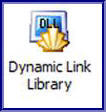Dynamic Link
Library
.DLL Extension

Introduction
For the Microsoft
Windows operating systems that are listed in the "Applies to"
section, much of the functionality of the operating system is
provided by dynamic link libraries (DLL). Additionally, when
you run a program on one of these Windows operating systems,
much of the functionality of the program may be provided by
DLLs. For example, some programs may contain many different
modules, and each module of the program is contained and
distributed in DLLs.
The use of DLLs
helps promote modularization of code, code reuse, efficient
memory usage, and reduced disk space. Therefore, the operating
system and the programs load faster, run faster, and take less
disk space on the computer.
When a program
uses a DLL, an issue that is called dependency may cause the
program not to run. When a program uses a DLL, a dependency is
created. If another program overwrites and breaks this
dependency, the original program may not successfully run.
With the
introduction of the Microsoft .NET Framework, most dependency
problems have been eliminated by using assemblies.
What is a DLL?
A DLL is a library that contains code and data that can be
used by more than one program at the same time. For example,
in Windows operating systems, the Comdlg32 DLL performs common
dialog box related functions. Therefore, each program can use
the functionality that is contained in this DLL to implement
an Open dialog box. This helps promote code reuse and
efficient memory usage.
By using a DLL, a
program can be modularized into separate components. For
example, an accounting program may be sold by module. Each
module can be loaded into the main program at run time if that
module is installed. Because the modules are separate, the
load time of the program is faster, and a module is only
loaded when that functionality is requested.
Additionally,
updates are easier to apply to each module without affecting
other parts of the program. For example, you may have a
payroll program, and the tax rates change each year. When
these changes are isolated to a DLL, you can apply an update
without needing to build or install the whole program again.

